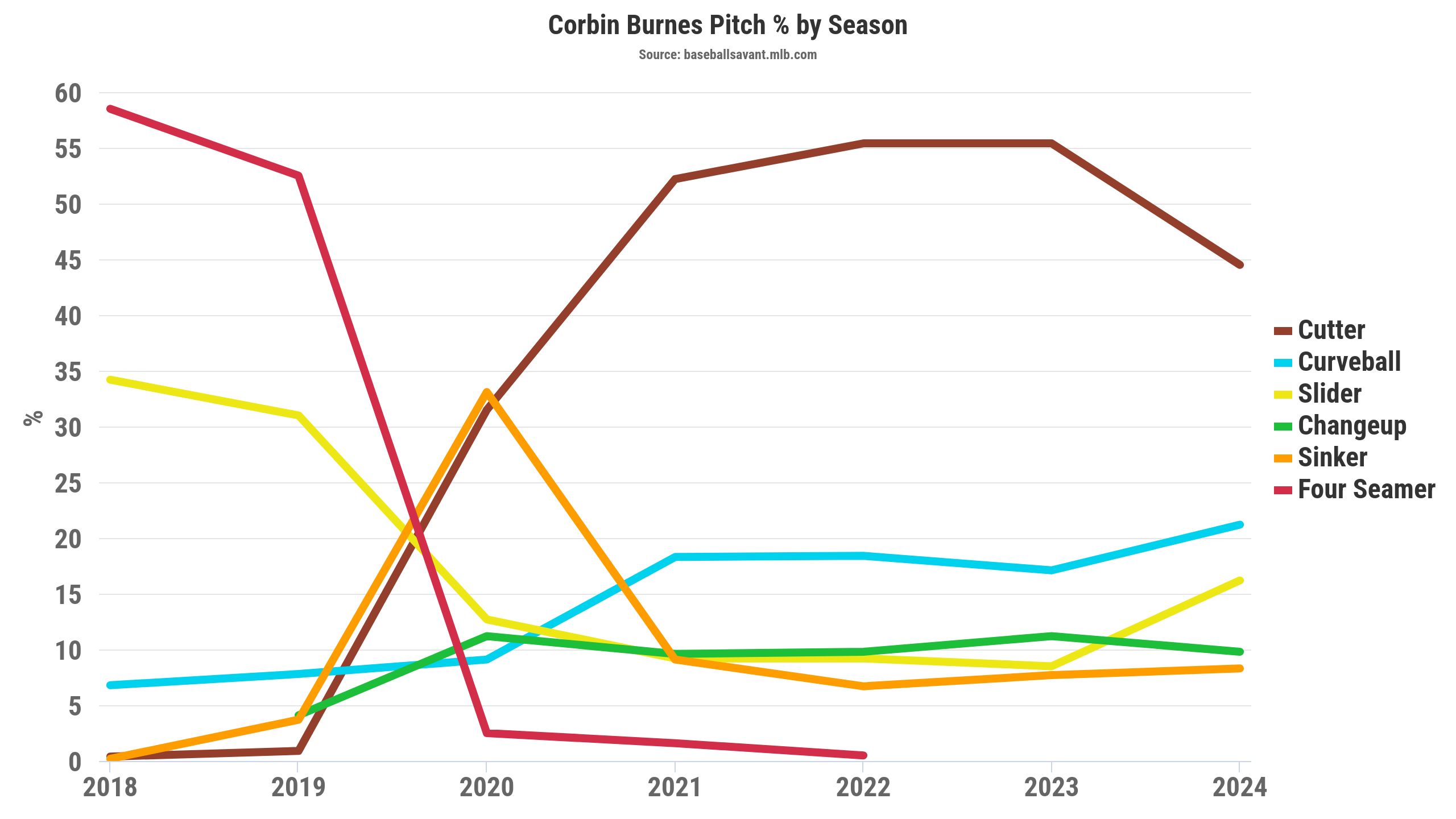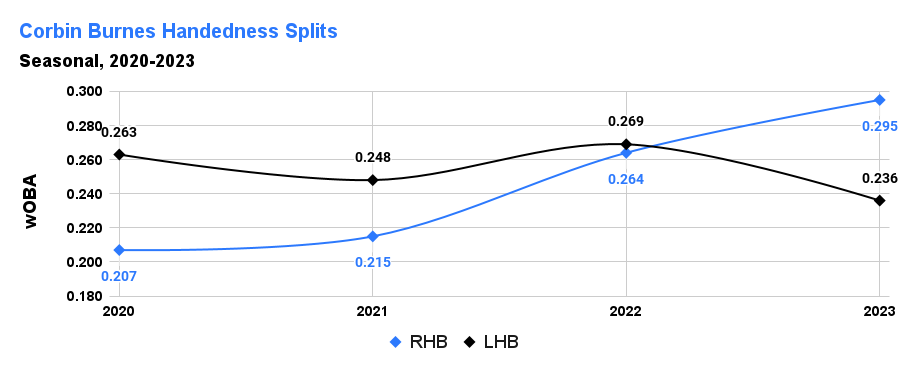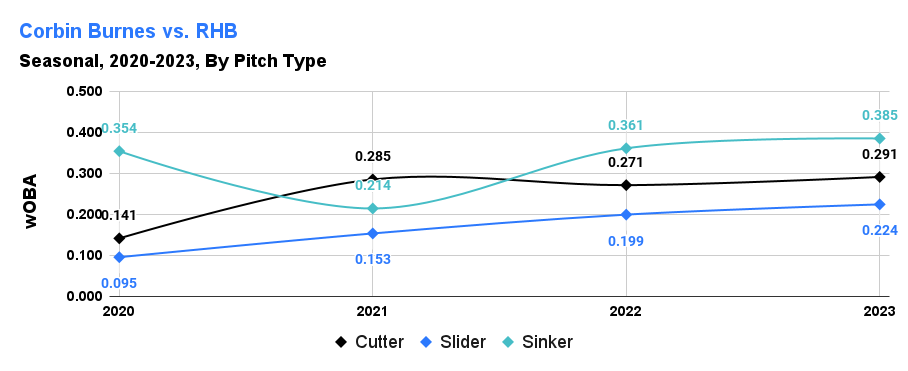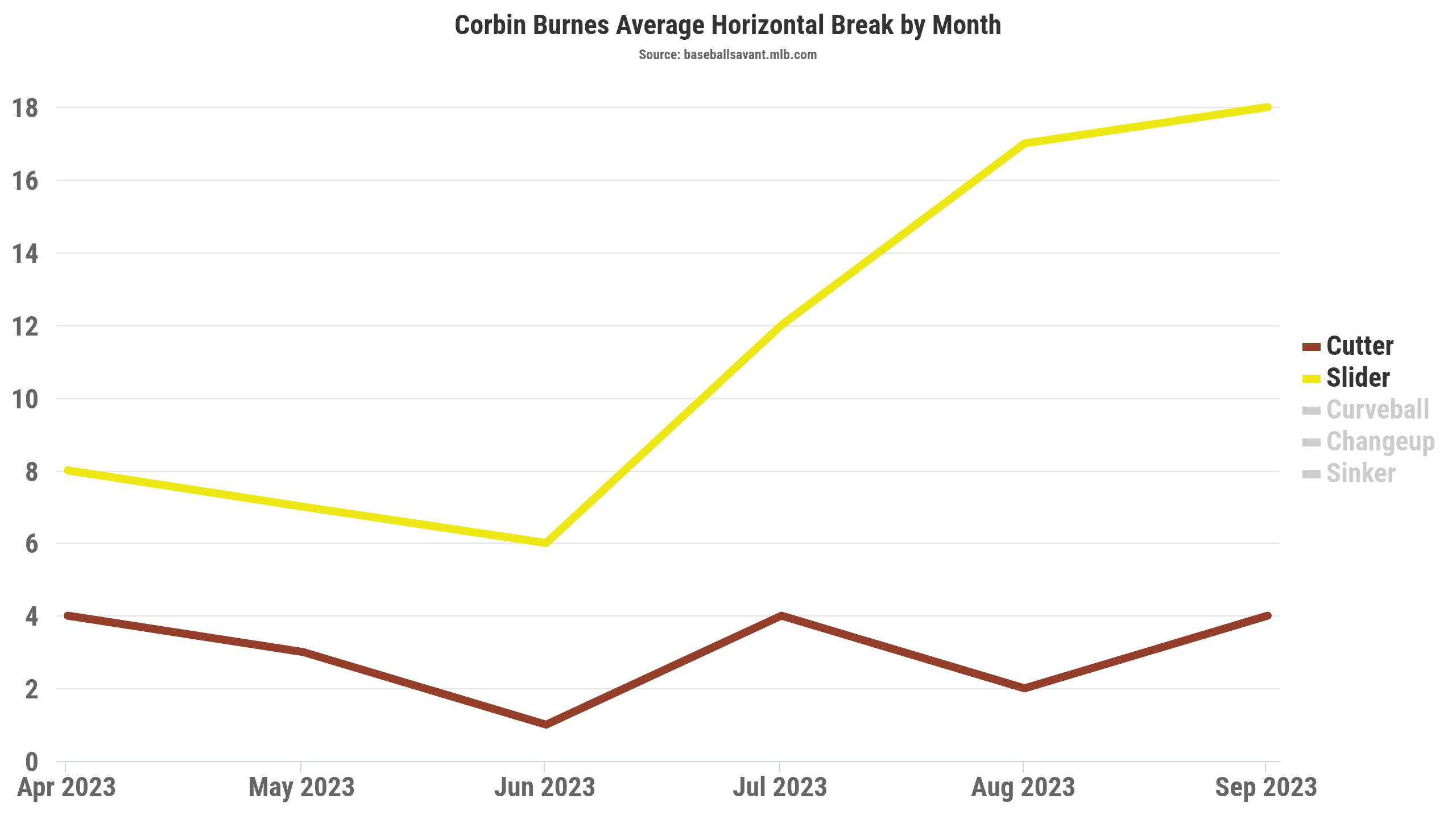We haven’t had a deep-dive article on Corbin Burnes here in a while. Sure, we talk about him all the time in our rankings and nasty pitch breakdowns, but our analysis-heavy pieces are often centered around pitchers and hitters who are doing something different that we want to understand and interpret… a new pitch, a new approach at the plate, or any number of other things that might offer the keys to explain a recent improvement or that might signal a brighter future.
That hasn’t been necessary for Burnes since he burst into stardom in 2020 and 2021. Since then, you know what you’re getting from him — sustained dominance thanks to a boatload of mid to upper-90s cutters supplemented by a complete array of secondary offerings moving every which way:

From Baseball Savant
Burnes’ pitch mix has been remarkably consistent since 2021 and he’s been amazingly effective. Dating back to the beginning of the 2020 season, Burnes ranks second in fWAR, third in innings pitched, fifth in ERA, second in FIP, and fourth in batting average against among 145 qualified pitchers. Perhaps only Zack Wheeler matches Burnes in terms of production and availability. He’s been a capital-A Ace in every sense of the word for the past several seasons.
Things are different this year, though. Now he’s in Baltimore after the offseason trade that installed him at the front of the AL contender’s rotation. And, if you take another peek at the right-hand side of that pitch mix plot above, you’ll see that it seems Burnes has made some adjustments to his approach in 2024. Now we’ve got something to work with for a Going Deep article!
Familiarity Breeds… Better Results (for hitters)
While Burnes was again excellent last season, he somewhat quietly had his “worst” season since becoming established:
You can see in the last row of the table that he struck out fewer batters, walked more, and posted ERA, FIP, and xERA marks that were his highest since 2020. Scan the whole table and you’ll see that each of those stats shows a multi-year trend of moving in the wrong direction.
Digging in on Burnes’ splits data reveals that right-handed hitters have been steadily gaining on him for a while:

Data from Baseball Savant
Where he’s held left-handed opponents to wOBAs in the mid-200s the past four seasons, right-handers have improved annually to the point where they performed better against Burnes than their platoon-advantaged counterparts last season.
At least some of that might be explainable by a slight decline in the quality of Burnes’ stuff compared to the past, as you can see by PLV measures in the table here:
We had Burnes’ arsenal down slightly last season, especially his signature cutter, but also his slider and sinker, which collectively have made up most of his attacks against right-handed hitters.
In the plot below, you’ll see that each of those pitch types performed worse against right-handers last season than they did the season before. And, except for the cutter, they performed worse in 2022 than in 2021.

Now, it’s important not to read too far into this. While the sinker numbers aren’t great, both the cutter and slider still got good results — they just weren’t quite as dominant as before.
Something different with those two pitches last season was their horizontal movement, which was on a declining trend in the 1st half as you can see on the left-hand half of the plot below:

The movement away from batters (i.e., Burnes’ glove side movement is going away from right-handed hitters) is often what gives pitchers a platoon advantage. Early last season, Burnes’ cutter and slider each lost an inch of glove-side break, explaining some of the right-handed hitters’ improvement against him.
At last season’s all-star break, Burnes went to work on this problem and came out with a different slider, which had much more sweep. Sweepers are well known to be platoon advantages and had been all the rage, so it was a logical adjustment for Burnes to pursue.
The slider tweak was effective on its own — .182 wOBA allowed on the pitch after the break, compared to .254 before — but it didn’t make much difference in Burnes’ top-line results. He had allowed a .298 wOBA to right-handed batters in the 1st half last season without a sweeping slider and then allowed a .292 wOBA to them in the 2nd half.
That suggests, as others have posited, that the root issue wasn’t just the movement changes, but that Burnes also had an issue with his pitch selection and sequencing against righties. Jack Stern published an excellent breakdown of this for Brew Crew Ball last fall, and the story is evident below:
This data reveals that Burnes didn’t increase his reliance on his upgraded slider. He continued to be very predictable in his pitch usage against right-handed hitters. Burnes’ upgraded slider didn’t cut into his cutter usage (see what I did there?) against right-handed hitters, which mostly stayed similar.
Baltimore Breaking Balls
Given the career pitch mix plot I showed you first in this article, you can probably guess what’s coming next. So far in his first season with Baltimore, Burnes has been more willing to mix up his pitches than he had shown in the past.
This season is the first time since his breakout that his cutter usage is under 50%, and both his slider and curveball have been used more often instead.
While he has thrown a few additional curveballs and changeups to left-handed hitters, those mix changes are most pronounced against right-handers, and he’s mixed up his sequencing to them to a greater degree than maybe ever before:
The table above, compared to last season, shows that he’s relied more heavily on his slider this season and also mixed in more curveballs to righties. More importantly, though, is that he’s also adjusted when he’s making those offerings.
Compared to last season, he’s gone away from his cutter more frequently when he’s been behind in the count (batter ahead row in the table above), instead trusting his breaking balls more to get back into counts. Similarly, once he gets ahead and to two strikes, he’s not coming back to the cutter as frequently, instead throwing his slider or curveball a combined 58% of the time in two-strike counts.
That all is helping him be less predictable and force opposing hitters to worry about a larger array of pitches, especially when they have the count advantage.
Sooo… problem is solved, right? He’s back to dominating righties? Rarely is baseball that simple, and this seems to be one of those cases.
After limiting righties to .295 wOBA last season, Burnes’ new approach has limited righties to… .295 wOBA so far in 2024. He’s working differently, but the top-line results are the same, likely in large part because he remains very predictable about where he’s throwing these pitches.
He’s increasingly worked the lower third and below the zone since 2020, to the point that more than two-thirds of his pitches are located there this season (that’s increased to more than 71% of his pitches to right-handed batters). At the same time, that increased rate of low pitches has returned poorer results and fewer missed bats as batters get more and more familiar with how he’s going to attack them and narrow down the real estate they need to defend against.
Opposing hitters know they can mostly just look down and away for cutters then continue to look there to defend against cutters and sliders (and the occasional curve) when he gets ahead or to two strikes. They have few reasons to defend inside, up in the zone, or sit on anything other than a pitch moving away, as Tim Muma has detailed for Brewer Fanatic.
The More Things Change…
Nonetheless, Burnes is again having a dominant season. Over 17 starts and 106.2 innings, he has a 2.28 ERA and 3.31 FIP that are back more in line with his prior dominance in Milwaukee. Also positive is that his overall PLV grade has increased to 5.23, and his cutter-specific PLV is back up to 5.38 (despite having lost another inch of horizontal break), while his slider and curveball have maintained their quality levels.
Others have pointed out that Burnes’ new approach is allowing more contact (albeit mostly harmless contact, per Matthew Trueblood at Brewers Fanatic) and striking out fewer batters this season. His batting average allowed is .216, up from the sub-.200s he routinely posted in Milwaukee and his strikeout rate has declined to 23.4%. But, he’s getting ground balls at the highest rate of his career (49.5%) and he’s cut down his walks to a near career-best 5.7%.
Opponents also seem to have adapted their approaches at the plate, as Burnes discussed in an interview earlier this season:
“We are seeing a different approach against me… …if they get to two strikes, they were doing all that they can to put the ball in play. I think that is kind of how the game is changing. You are seeing lineups change to more of a contact approach. Things tend to happen more when the ball is put in play.
The data bears that out. This season, hitters facing Burnes have been more aggressive, especially early in counts. His first strike rate is a career-high 66.4%, but the percentage of his pitches that come with two strikes has declined from over 30% in 2020-2022 to 28.6% this year. Accordingly, Burnes’ early ball-in-play rate has risen to 15.6% after previously living in the 11-12% range.
Burnes has faced a higher share of right-handed hitters this season than in the past. Of the 423 batters he’s faced this season, 246 (58.2%) have swung right-handed, which is higher than the 50.5% and 48.9% he faced the past two seasons.
I wondered if that’s a result of the move to the AL East, but only six of Burnes’ 17 starts have been against AL East teams thus far. Instead, it seems opposing teams are more liberally deploying their right-handed hitters against Burnes and trying to exploit his slightly reversed platoon splits.
Burnes doesn’t seem to mind those changes and recognizes that further adjusting how he sequences his pitches may be part of his future:
“It will be about sequencing a little better,” he said. “Instead of a guy fouling off three of four pitches with two strikes, just let him put it in play. Or do whatever you can do to end the at-bat in three or four pitches versus that six-or-seven-pitch range.
“I am happy with how my stuff looks. Happy how the ball is coming out. Maybe a tweak here or there in sequencing could get a few more strikeouts.”
He’s already taken the needed step to diversify his sequencing and trust his other stuff more. What might be (should be?) next is diversifying where he targets within the zone. I wrote about the Royals’ Brady Singer targeting the upper regions of the zone to mix up his looks earlier this season and Burnes might fall in a similar boat.
Primarily working down and away is not inherently a bad thing given the shape of his arsenal and the strength of his stuff. He’s continued to find immense success by sticking to his strengths. But strengths in the extreme can sometimes be wielded against you, which might be starting to happen. The great ones find ways to evolve new weapons and approaches from their strong foundations.
It will be fun to watch Burnes’ next iteration, and I hope it might include a more diverse swath of locations, especially in the upper parts of the zone.
Photos by Icon Sports Wire and Wikimedia Commons | Adapted by Carlos Leano

